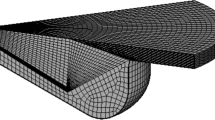Abstract
In diesel engines, NOx formation is a highly temperature-dependent phenomenon and takes place when the temperature in the combustion chamber exceeds 2000 K. Therefore, in order to reduce NOx emissions in the exhaust, it is necessary to keep peak combustion temperatures under control.
One simple way of reducing the NOx emission of a diesel engine is by late injection of fuel into the combustion chamber. This technique is effective but increases fuel consumption by 10–15%, which necessitates the use of more effective NOx reduction techniques like exhaust gas recirculation (EGR). Re-circulating part of the exhaust gas helps in reducing NOx, but appreciable paniculate emissions are observed at high loads, hence there is a trade-off between NOx and smoke emission. To get maximum benefit from this trade-off, a paniculate trap may be used to reduce the amount of unburnt particulates in EGR, which in turn reduce the paniculate emission also.
An experimental investigation was conducted to observe the effect of exhaust gas re-circulation on the exhaust gas temperatures and exhaust opacity. The experimental setup for the proposed experiments was developed on a two-cylinder, direct injection, air-cooled, compression ignition engine. A matrix of experiments was conducted for observing the effect of different quantities of EGR on exhaust gas temperatures and opacity
Similar content being viewed by others
References
Baert R S G, Beckman D E, Veen A 1999 Efficient EGR technology for future HD diesel engine emission targets.SAE 1999-01-0837
Heywood J B 1988 Pollutant formation and control.Internal combustion engine fundamentals Int. edn (New York: Mc-Graw Hill) pp 572–577
Kohketsu S, Mori K, Sakai K, Hakozaki T 1997 EGR technologies for a turbocharged and inter-cooled heavy-duty diesel engine.SAE 970347
Levendis Y A, Pavalatos I, Abrams R F 1994 Control of diesel soot hydrocarbon and NOx emissions with a particular trap.SAE 940460
Lundquist U, Smedler G, Stalhammar P 2000 A comparison between different EGR systems for HD diesel engines and their effects on performance, fuel consumption and emissions.SAE 2000-01-0226
Mehta S, Oey F, Sumbung C L, Levendis Y A 1994 An aerodynamically regenerated diesel particulate trap with a flow-through soot incinerator section.SAE 940461
Pierpont D A, Montgomery D T, Reitz R D 1995 Reducing particulate and NOx using multiple injections and EGR in a D. I. diesel.SAE 950217
Sher E 1998 Motor vehicle emissions control: Past achievements, future prospects.Handbook of air pollution from IC engines pollutant formation and control (San Diego, CA: Academic Press) pp 9–10
Stearns R F, Johnson R R, Jackson R M, Larson C A 1951 Derivation of flow equations.Flow measurements with orifice meters (Princeton, N J: D V N Com.) p-4
Zelenka P, Aufinger H, Reczek W, Cartellieri W 1998 Cooled EGR-A technology for future efficient HD diesels.SAE 980190
Author information
Authors and Affiliations
Rights and permissions
About this article
Cite this article
Agrawal, A.k., Singh, S.K., Sinha, S. et al. Effect of EGR on the exhaust gas temperature and exhaust opacity in compression ignition engines. Sadhana 29, 275–284 (2004). https://doi.org/10.1007/BF02703777
Received:
Revised:
Issue Date:
DOI: https://doi.org/10.1007/BF02703777




